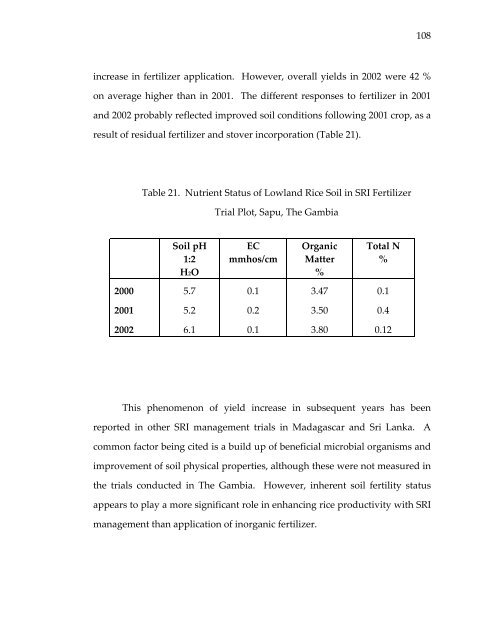Management of rice production systems to increase productivity
Management of rice production systems to increase productivity
Management of rice production systems to increase productivity
You also want an ePaper? Increase the reach of your titles
YUMPU automatically turns print PDFs into web optimized ePapers that Google loves.
<strong>increase</strong> in fertilizer application. However, overall yields in 2002 were 42 %<br />
on average higher than in 2001. The different responses <strong>to</strong> fertilizer in 2001<br />
and 2002 probably reflected improved soil conditions following 2001 crop, as a<br />
result <strong>of</strong> residual fertilizer and s<strong>to</strong>ver incorporation (Table 21).<br />
2000<br />
2001<br />
2002<br />
Table 21. Nutrient Status <strong>of</strong> Lowland Rice Soil in SRI Fertilizer<br />
Soil pH<br />
1:2<br />
H2O<br />
5.7<br />
5.2<br />
6.1<br />
Trial Plot, Sapu, The Gambia<br />
EC<br />
mmhos/cm<br />
0.1<br />
0.2<br />
0.1<br />
Organic<br />
Matter<br />
%<br />
3.47<br />
3.50<br />
3.80<br />
Total N<br />
%<br />
0.1<br />
0.4<br />
0.12<br />
108<br />
This phenomenon <strong>of</strong> yield <strong>increase</strong> in subsequent years has been<br />
reported in other SRI management trials in Madagascar and Sri Lanka. A<br />
common fac<strong>to</strong>r being cited is a build up <strong>of</strong> beneficial microbial organisms and<br />
improvement <strong>of</strong> soil physical properties, although these were not measured in<br />
the trials conducted in The Gambia. However, inherent soil fertility status<br />
appears <strong>to</strong> play a more significant role in enhancing <strong>rice</strong> <strong>productivity</strong> with SRI<br />
management than application <strong>of</strong> inorganic fertilizer.
















